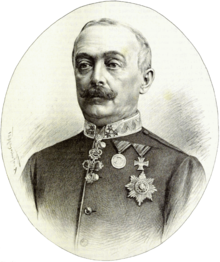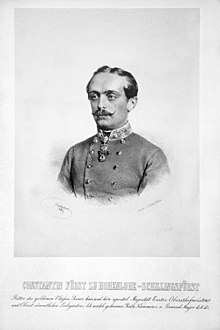Konstantin zu Hohenlohe-Schillingsfürst
Konstantin Viktor Ernst Emil Karl Alexander Friedrich, Prince of Hohenlohe-Schillingsfürst (born September 8, 1828 in Wildeck , Hesse , † February 14, 1896 in Vienna ) was the kuk First Colonel and General of the Cavalry in Austria-Hungary .
Life
family
Prince Konstantin was the youngest son of Prince Franz Joseph zu Hohenlohe-Schillingsfürst. His three older brothers were
- Victor Herzog von Ratibor , President of the Prussian Mansion ,
- Chlodwig zu Hohenlohe-Schillingsfürst , German Chancellor as well
- Cardinal Gustav Adolf zu Hohenlohe-Schillingsfürst .
He also had three sisters and two other brothers who died at an early age.
1859 married Prince Konstantin in Weimar Princess Marie Sayn-Wittgenstein (1837-1920), daughter of the divorced Princess Carolyne zu Sayn-Wittgenstein (1819-1887), which since 1849 with Franz Liszt lived in Weimar. Princess Marie had spent her youth in Weimar and on trips with poets and artists. In Vienna, where she lived with her husband from 1862 in Palais Dobner-Dobenau , which he had bought in 1861, she promoted art and cultural life and got involved in social institutions. Her favorite poet was Friedrich Hebbel , who lived in Vienna . Anton Bruckner , member of the Wiener Hofmusik-Kapelle, dedicated his Symphony No. 4 in E flat major , the “Romantic” , to Hohenlohe in 1881 - and Johann Strauss Sohn dedicated his Waltz Stories from the Vienna Woods in 1868 .
His children were:
- Prince Franz Joseph zu Hohenlohe-Schillingsfürst (1861–1871)
- Prince Konrad zu Hohenlohe-Schillingsfürst (1863-1918)
- Prince Philipp zu Hohenlohe-Schillingsfürst (1864–1942), Father Konstantin OSB
- Prince Gottfried zu Hohenlohe-Schillingsfürst (1867–1932), ∞ Archduchess Maria Henriette of Austria-Teschen (1883–1956)
- Prince Wolfgang zu Hohenlohe-Schillingsfürst (1869-1883)
- Princess Dorothea zu Hohenlohe-Schillingsfürst (1872-1954)
career

Photo by Th.Mayerhofer from the 'Wiener Salonblatt', vol. 24, no.6, p.1 (February 5, 1893).
Konstantin attended the Maria-Magdalenen-Gymnasium in Breslau , which he left with the Abitur in 1848 with the note: "will devote himself to the military class". In the same year he entered the service of the Austrian crown . In 1849 he took part in the Northern Italian campaign, in 1854 he entered the Austrian court service , in 1859 he became Emperor Franz Joseph I's wing adjutant .
In July 1866 after the disastrous for Austria Battle of Königgrätz , Constantine Hohenlohe became the first High Steward appointed. At the same time he and his wife received the personal title of prince with the predicate “Princely graces”. He was considered a consummate courtier, his actions always coincided with the political line of the emperor, who was two years younger than him. The chief steward was at the center of political and social life at the Viennese court ; When the unified empire until 1866 was reclassified into the dual monarchy Austria-Hungary in 1867 , the chief stewardship, responsible for both halves of the empire, was given the designation kuk
After the removal of the city fortifications ordered by the Emperor in 1857, construction activity began for decades with the construction of the Vienna Ringstrasse . The duties of the High Steward included the responsibility for buildings and property of the imperial court, on the ring road completion of the Imperial Court Opera , and later the construction of the Imperial Court Theater and the construction of two new imperial museums, the Art History and the Natural History Museum . Construction of the New Castle began near the Hofburg and would last until the First World War. The Vienna Prater , the former imperial hunting ground, saw major changes on the occasion of the Vienna World Exhibition in 1873 (Hohenlohe was involved in the construction management; the Constantine Hill that was newly built up in the Prater was named after him) as well as in connection with the Danube regulation completed in 1875 . As a friend of the fine arts, he brought well-known artists to Vienna to design the new imperial buildings. As the top boss of the court theater, he was often asked to act as a mediator in disputes over competence.
In negotiations with various political, social and ethnic delegations he always represented the emperor's opinion; anything else would have been unthinkable in its function. In addition, he had to fulfill many official obligations when visiting foreign dignitaries who, as far as their appearance at court was concerned, had to be looked after by the chief steward's office. These increased significantly on the occasion of the world exhibition.
Hohenlohe's ambition to keep all the strings in hand pushed him to the limits of his performance in the varied tasks. The burden of duties and responsibilities increasingly affected his health. He has been described as smart, energetic, and energetic. The busy chief steward was valued for his quick-wittedness and storytelling talent, but he could also be quick-tempered. Hohenlohe remained First Chief Chamberlain until his death, followed by Rudolf von Liechtenstein .
Awards
Prince Constantine Hohenlohe was 1870 Honorary Member of the Society of Friends of Music and in 1873 in honor curator of the Academy of Fine Arts Vienna and honorary curator of the Austrian Museum of Art and Industry . As King of Hungary he received the Grand Cross of the Royal Hungarian Order of St. Stephen , was appointed a lifelong member of the manor house of the Austrian half of the empire and in 1883 was awarded the Order of the Golden Fleece , the house order of the Habsburg-Lorraine dynasty and the highest-ranking order in the entire monarchy, excellent. Hohenlohe was also the bearer of the highest orders of almost all European royal houses.
literature
- Constantin von Wurzbach : Hohenlohe-Waldenburg-Schillingsfürst, Constantin Prinz . In: Biographisches Lexikon des Kaiserthums Oesterreich . 9th part. Kaiserlich-Königliche Hof- und Staatsdruckerei, Vienna 1863, p. 202 ( digitized version ).
- Hohenlohe-Schillingsfürst Konstantin Prinz to. In: Austrian Biographical Lexicon 1815–1950 (ÖBL). Volume 2, Publishing House of the Austrian Academy of Sciences, Vienna 1959, p. 393 f. (Direct links on p. 393 , p. 394 ).
- Barbara Boisits: Hohenlohe-Schillingsfürst, Konstantin Prinz zu. In: Oesterreichisches Musiklexikon . Online edition, Vienna 2002 ff., ISBN 3-7001-3077-5 ; Print edition: Volume 2, Verlag der Österreichischen Akademie der Wissenschaften, Vienna 2003, ISBN 3-7001-3044-9 .
- Martina Winkelhofer-Thyri: Prince Constantin zu Hohenlohe-Schillingsfürst (1828-1896). The great stranger at the Viennese court. In: Alma Hannig, Martina Winkelhofer-Thyri (eds.): The Hohenlohe family. A European dynasty in the 19th and 20th centuries . Verlag Böhlau, Cologne 2013, ISBN 978-3-41222201-7 , pp. 181-198.
Web links
- Entry on Konstantin zu Hohenlohe-Schillingsfürst in the Austria Forum (in the AEIOU Austria Lexicon )
- All sorts of things from Prince Hohenlohe. In: Wiener Salonblatt , February 15, 1896, p. 3 (online at ANNO ). (News of death)
Individual evidence
- ↑ See Hof- und Staatshandbuch des Kaiserthumes Österreich , Vienna 1868, p. 9.
| personal data | |
|---|---|
| SURNAME | Hohenlohe-Schillingsfürst, Konstantin too |
| ALTERNATIVE NAMES | Hohenlohe-Schillingsfürst, Konstantin Viktor Ernst Emil Karl Alexander Friedrich Fürst too |
| BRIEF DESCRIPTION | Austrian chief steward and general |
| DATE OF BIRTH | September 8, 1828 |
| PLACE OF BIRTH | Wildeck |
| DATE OF DEATH | February 14, 1896 |
| Place of death | Vienna |
